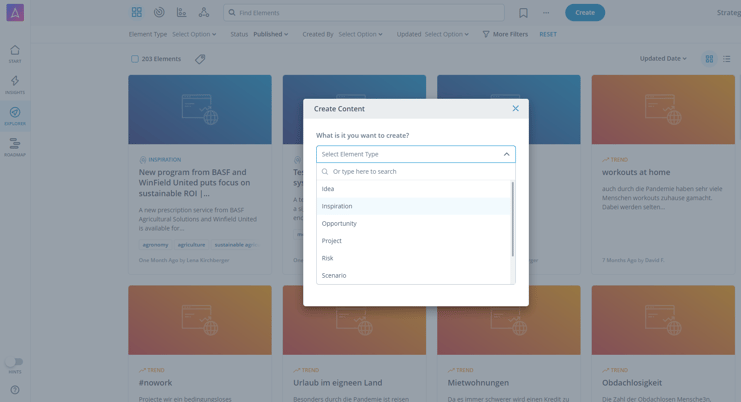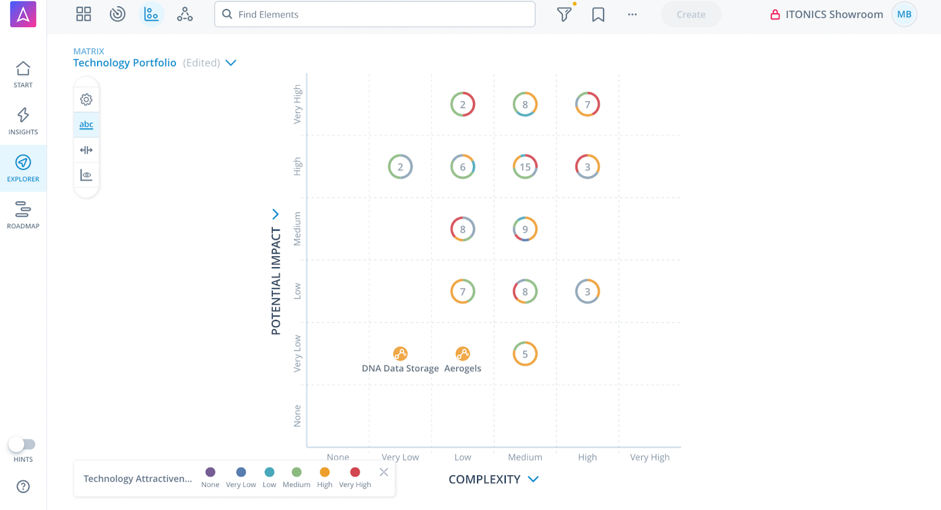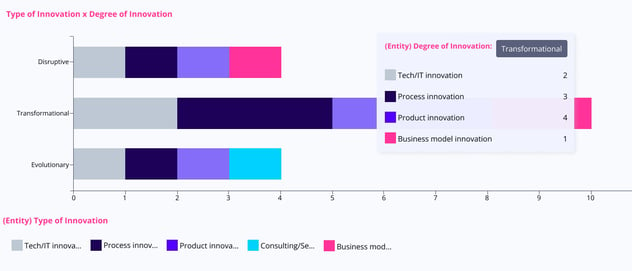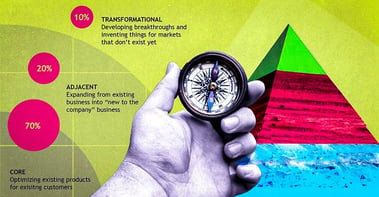Radical or incremental? New products or improved processes? CIOs leading innovation are mandated to strike a balance between quick wins and moonshots.
To bring balanced innovation portfolios to life, executive leaders must focus resources to support a strategically aligned composition of core, adjacent, and transformational initiatives. This article details how to set up agile innovation-, project- and technology- portfolios using ITONICS and enable impactful decision-making for effective action planning.
What is (agile) innovation portfolio management?
An innovation portfolio is a set of ideas, projects, and programs that the organization manages as it would with a set of investments to obtain direct results and objectives focused on an innovation strategy. By collaboratively evaluating proposed innovation projects and portfolios, organizations equip themselves to pursue initiatives that hold the most significant potential selectively. It is essential to align innovation strategy with business goals, assess internal capabilities and match resources to selected initiatives on an ongoing basis. This is the task of innovation portfolio management.
Therefore, (agile) innovation portfolio management can be described as the ongoing process of adapting the allocation of finite resources into opportunity areas and then into specific projects aligned to meet strategic goals.
In principle, innovation portfolio management is a method for organizations to align innovation assets and capabilities with their strategic objectives. It entails selecting and prioritizing projects to identify gaps or redundancies, allocate finite resources, and balance growth initiatives within the business. Practical innovation methodologies such as The Three Horizons Model and The 7 Dimensions to Prioritize Innovation Efforts, as recommended by Gartner®, provide an excellent guide for business leaders who want to optimize their innovation investments and drive value through an effective, targeted innovation strategy.
Effective implementation of innovation strategy relies on continuously making choices to win in the marketplace - in the short, mid, and long term. The economic environment we operate in today faces constant disruption, change, and aggressive competition. As a result, innovation strategy should not be considered absolute. Organizations must equip themselves with the tools to plan and adapt innovation portfolios accordingly, with greater agility and speed.
Six steps to manage your innovation portfolios with ITONICS
1. Create, consolidate, and rate opportunities and projects
To begin building your innovation portfolio, you must first create new opportunities, ideas, projects, and/or programs as pieces of content referred to as Elements in the ITONICS Innovation OS. To do this, click "Create +" button at the top of the ITONICS window view. This will provide a list of options of the content types you can create. Select the option most relevant to you. Once created, all content will be visible on the ITONICS Explorer and can be pulled into various visualizations as required.

Enrich each piece of content with information such as descriptions, project time frames, KPI’s, budget information, relations, tags, and references to provide context and support cross-collaboration. Rate each opportunity and/or project to assist evidence-based evaluation of your portfolio. This can be done by selecting the "Rate Now" button on each opportunity or project. Rating criteria can be customized to include metrics considered critical and influential to the success of your innovation strategy. These include general characteristics, such as maturity or disruptiveness, and company-specific parameters, like cost-saving potential, internal know-how, or implementation risk.
2. Map, analyze, and prioritize opportunities and projects
Use ITONICS Matrix to enable users to analyze, track, monitor, and re-evaluate their innovation portfolios in an agile way. Multiple portfolios can be added and selected for evaluation using the drop-down toggle on the left-hand side of the visualization. Once decided, the tool will bring all your content into view on an X and Y axis for evaluation. This allows users to visualize and prioritize projects within the sweet spot of their specific evaluation criteria.

Get started quickly with ITONICS best-practice templates to evaluate portfolio risk and potential. Easily adjust views using the drop-down selections on each X- and Y-axis to find the most suitable combination for your business need. Configure the matrix view to aid internal alignment further and reflect your company's existing terminology. Apply custom category labels to each quadrant for easy analysis. Save your modified Matrix to view later and share with colleagues.
3. Balance your innovation portfolio
Shift your view to ITONICS Kanban Boards to gain perspective on your full portfolio, manage and prioritize projects accordingly, and identify gaps where strategic options are needed. Boards are structured in columns and swimlanes, using various colors to provide a clean, visual overview of your innovation portfolio. Boards let you organize your portfolio by allowing you to add and drag-and-drop projects across sections like sticky notes. Boards also give you the power to aggregate and track project KPIs and budget considerations to support decision-making further.
Begin using best-practice views or configure your Board to reflect your company's existing segmentation and processes. Columns are used to visualize the workflow or project stages easily. In contrast, swimlanes indicate the various work streams, and color categories portray the status of various projects. These dimensions can be changed according to the view needed using the toggles on the left-hand side of the visualization.
A preview of that project opens on the right if you click a card inside the Kanban Board. Here you can see an overview of the basic info such as the Title, Abstract, and the Relations of that project. You can also find some quick actions to open, follow, rate, edit or delete the project if you have permission to do so. Easily drag and drop projects to visualize various portfolio options and demonstrably see the implications of certain decisions. You can save your modified Board view to reuse and share with colleagues.
4. Establish clear processes to qualify and manage innovation projects
A workflow is how you get work done. ITONICS Workflow consists of a coordinated and repeatable pattern of actions, enabled by the systematic organization of resources into processes. Workflows assist in moving project information through various stages, from initiation to completion. It's the sequence of tasks from start to finish: The process.
To streamline and standardize your project portfolio, you can design a Workflow that speaks to your organization and aligns all involved stakeholders. You can define the configuration of the Workflow steps or apply some of our best-practice templates to kickstart your process.
The Workflow is controlled and regulated using call-to-action buttons equipped with some handy functionality. These ask users to complete specific tasks before others may proceed with certain actions or the project can be moved to the next phase within the pre-defined process. Workflow dependencies can be configured to ensure that Workflows adhere to your company's requirements at each stage of the process.
5. Track and manage projects in the process
To ensure standardized quality within the different workflow steps you have defined for your project, technology, or product portfolio, you can pre-define specific tasks required (or optional) for the different steps. You can use ITONICS Tasks as a stand-alone tool to track and manage specific tasks. Most of the time, tasks are combined with the Workflow engine to assign individual tasks to the specified Workflow phases and allocate them to specific task owners accordingly. You can get started quickly with tasks by planning deliverables alongside Workflows.
For every phase you define within the Workflow configuration, you can configure a dependency on the assigned tasks to the respective Workflow phase. This means that you are able to predefine what is needed to move forward in each phase. To define different conditions for those dependencies, it is important to configure tasks to reflect what is required.
Similar to other data objects in the system, you can configure the naming and structure of tasks easily. Based on your team's preference, tasks can be renamed to activities, deliverables, or action items as an alternative. While tasks usually come with the default configuration, including Title, Description, Status, Priority, Due date, Assignee, and Workflow step, these can be changed too. In this way, you can modify or create your custom task templates to reflect your company's existing structures, reporting, and processes for cross-functional alignment.
6. Consolidate data to report on innovation portfolio developments and results
A dashboard is a visual display of all of your data. ITONICS Dashboard is a visualization tool that consolidates the generated input of your project portfolio graphically for quick reading, comparison, and analysis. While it can be configured and used in all kinds of different ways, its primary intention is to provide information at a glance. Perfect for monitoring, reporting, and the ideal mechanism to gain additional buy-in and commitment from decision-makers.

Working with ITONICS Dashboards enables your team to create compelling overviews to understand the data and generate valuable insights for your innovation journey. Visualize your portfolio data to identify gaps and redundancies in your portfolio. Build custom dashboards in ITONICS with the dashboard configuration. You can choose a wide range of chart types, customized data groups, and filters. Add your Dashboard charts to provide tailored reports that meet your requirements. Use the newsletter function to incorporate Dashboard views into regular updates to engage teams and stakeholders and keep them up-to-speed on innovation developments and results.
Setting up agile innovation portfolios: What’s next?
Rather than hoping that your organization's future will be derived from several ad hoc, stand-alone efforts that compete with one another for resources, your growth strategy must be considered holistically.
(Agile) innovation portfolio management provides a birds-eye perspective so that teams can manage various project initiatives as part of an integrated whole to achieve strategy effectively and ensure long-term return on investment. When interlinked with innovation roadmaps, portfolio management has even greater power.
The ITONICS Innovation OS offers further integration through ITONICS Roadmap, a planning tool that offers strategists the power to communicate the direction products, technology, and innovation will take. By linking portfolios to roadmaps, teams are better equipped to align efforts, identify synergies, develop integrated project pipelines and implement innovation programs effectively.
See it for yourself in a free demo with one of our experts and learn more about the features and functionalities of the ITONICS Innovation OS!



/Assets%20and%20Heros/nav-thumbnail-Gartner.webp?width=150&name=nav-thumbnail-Gartner.webp)








